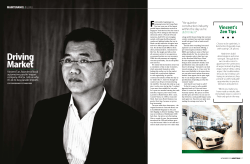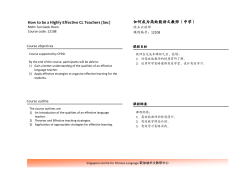
[IN - 12] ST/IN/PAGE 05/01/15
THE STRAITS TIMES FRIDAY, JANUARY 2, 2015 12 2. ARCHER ATTACK By: PUB, the national water agency By: Siblings Peh Guan and Peh Yong Arguably Singapore’s most talked-about success story, Newater refers to the high-grade reclaimed water that is purified with advanced membrane and ultraviolet technologies. The ultra-clean water has aced more than 110,000 scientific tests and surpasses the World Health Organisation’s requirements for safe drinking water. More importantly, the reclaimed water ensures that the taps in Singapore do not run dry. Newater, which made its public debut during the National Day Parade in 2002, was a result of about three decades of research. The foam from your soapy bathwater could be turned into a weapon system that can take down enemy aircraft. Peh Guan, then five, teamed up with his sister Peh Yong, then nine, and came up with “Archer Attack”, which won them an Encouragement Award at the Tan Kah Kee Young Inventors’ Award 2013. Ground troops can use Archer Attack, a light defence option, against air attacks. When an enemy aircraft approaches, a soldier can fire capsules containing sticky foam balls into the air, using an M203 grenade launcher. When these foam balls are sucked into airplane engines, they force the turbines to slow down or stop. The team from Awak Technologies includes (from left) general manager Jasmin Wong, operations director Lim Yong Soon, chairman Gordon Ku, executive director Neo Kok Beng and finance director Lilian Ng (seated). Making 3. CREATIVE SOUND BLASTER By: Creative Technology Ltd In 1989, home-grown Creative Technology introduced a product that soon became one of the most recognised names in the personal computer audio market. The Sound Blaster sound card, considered a breakthrough at the time, not only made digital music-playing widely available, but also enabled PC users to record voice clips and connect their PCs to musical instruments. First launched at Comdex 1. NEWATER ’89, a leading international computer trade show held annually in Las Vegas, the United States, 600 units of the sound card were sold over the five-day show. As of 2013, more than 400 million Sound Blaster products, including speakers and gaming headsets, have been sold worldwide. 4. AWAK PD By: Awak Technologies Dialysis treatments often take up several hours each day, making it difficult for kidney patients to go to school, work or travel. But, for water dialysis patients, all that could change when clinical trials of a portable device begin in 2017. The automated artificial kidney peritoneal dialysis device – or the Awak PD – mimics a real kidney and is able to provide water dialysis round the clock. Weighing history Since the 1980s, made-in-Singapore inventions have been making names for themselves worldwide. NUR SYAHIIDAH ZAINAL checks out 10 of them less than 1kg, it can be worn on a belt or carried in a bag. Currently, patients on water dialysis are hooked up to a large non-portable device and each dialysis session takes up to eight hours. Two American researchers first dreamed up such a device in the 1980s. Singaporean kidney specialist, Dr Gordon Ku, heard of the idea and started the company to develop it, working together with the Americans and Temasek Polytechnic. This system would help at least 800 patients in Singapore and 196,000 patients worldwide, who are on home-based water dialysis. 6. INFRARED FEVER SCREENING SYSTEM By: ST Electronics and the Defence Science and Technology Agency 5. LARVAE-EATING ROBOTIC FISH All the Infrared Fever Screening System needs is a moment to detect if someone has a fever. The world’s first non-invasive screening system takes thermographs of people, allowing easy identification of those with high fever: red means hot, green means not. The system was developed within two days during the Severe Acute Respiratory Syndrome (Sars) outbreak in 2003. High fever is a primary symptom of highly conta- gious diseases such as Sars and avian flu (bird flu) – which border patrol officers and hospital staff watch out for. Dozens of the systems were sold and used in public spaces, such as airports, hospitals and hotels, throughout Asia. 8. GLYDESAFE By: Ms Serene Tan (Sorgen) By: Mr Teo Kai Cheng, Ms Yeung Tsz Tsam (centre) and Ms Daphne Tan (Temasek Polytechnic) This robot fish is no toy. Its mission? Combat dengue. Just like real fish, the robotic fish “eat up” mosquito larvae in ponds or rivers to fight the spread of dengue. What sets it apart is that they can do so in dirty water – which fish generally cannot survive in. The gadget first sucks up the larvae using a vacuum tube in its “mouth”. A sharp-edged turbine inside it then minces the larvae. The remains are then discharged through a small opening below the tail. The device will not harm live fish and eggs, which are too large to fit into the vacuum tube. Its inventors are still looking to commercialise it. 9. ROTIMATIC 7. SELF-CLEANING MEMBRANES By: Associate Professor Darren Sun (Nanyang Technological University) Membranes are used to filter impurities from waste water, but cleaning them is costly. Now, a self-cleaning membrane could save companies millions of dollars. They do not require expensive cleaning chemicals, are expected to last twice as long and break less easily. The invention, marketed by an NTU start-up, has already been snapped up by firms in the region, such as for an industrial paper mill in Guangzhou, China. Associate Professor Darren Sun (left) and Adjunct Professor Wong Ann Chai, co-founder and managing director of NTU start-up Nano Sun, fitting their newly developed membrane into a water filtration system. In 2011, Ms Serene Tan spotted an elderly person struggling to move while using a walking frame. The encounter resulted in Ms Tan’s invention of the GlydeSafe, a walking frame with a wheeled attachment. Users can roll the frame, instead of having to lift it up with each step. There is also an automatic brake for safety. Ms Tan, who worked on the idea as her final-year project at Temasek Polytechnic, won several awards for her invention, including a silver award at the 2011 Tan Kah Kee Young Inventors’ Awards. The product was first used in a trial run at 24 hospitals and elder care and rehabilitation centres nationwide before being launched in 2013. There are currently two GlydeSafe models on sale – the GlydeSafe Sleek is $99, while the GlydeSafe Travel, which has a retractable seat, costs $120. By: Mr Rishi Kumar and Ms Pranoti Israni (Zimplistic) Love eating chapati but have no idea how to make it? Well, now you can enjoy ready-to-eat Indian flatbread without too much hassle by making it using an automatic chapati maker.The Rotimatic, the first kitchen device of its kind, can produce one chapati per minute. Users can customise the bread’s thickness and softness, and vary the amount of oil and type of flour used by following instructions on a digital panel. About $5 million worth of the Rotimatic have been pre-sold to American customers and will start shipping this year. 10. CAROUSELL By: Mr Quek Siu Rui, Mr Marcus Tan and Mr Lucas Ngoo This mobile marketplace allows people to sell and buy products directly on their smartphones. Carousell’s unique selling point is its easy-to-use interface. Users simply snap a photo of their items before listing them for sale. Shoppers can filter the posts by location. This makes collecting or delivering products more convenient. Mr Quek Siu Ru, a co-founder, said Singapore is the app’s largest market, followed by Malaysia. Late last year, it raised US$6 million (S$7.8 million) from investors led by Sequoia Capital. PHOTOS BT FILE, CAROUSELL, COURTESY OF AARON BOO GUAN XIAN, LIANHE ZAOBAO FILE, ST FILE, TEMASEK POLYTECHNIC, ZIMPLISTIC
© Copyright 2025












